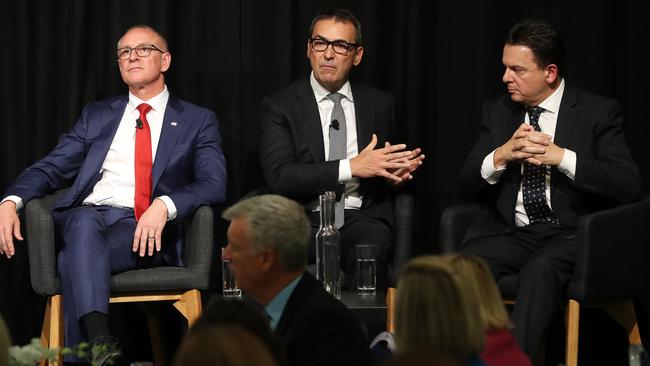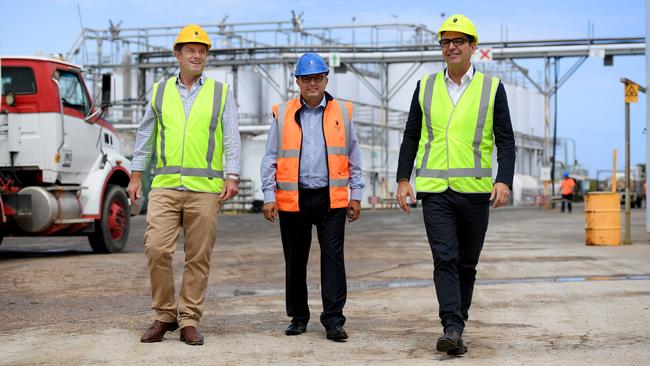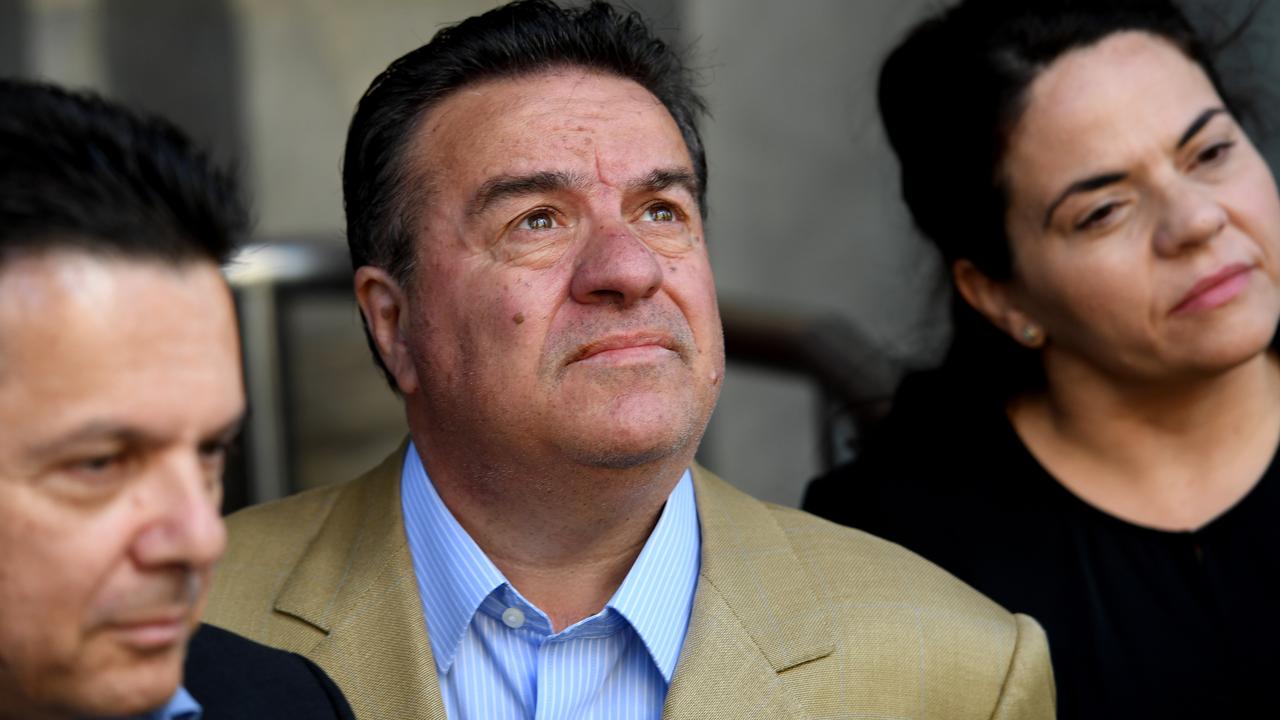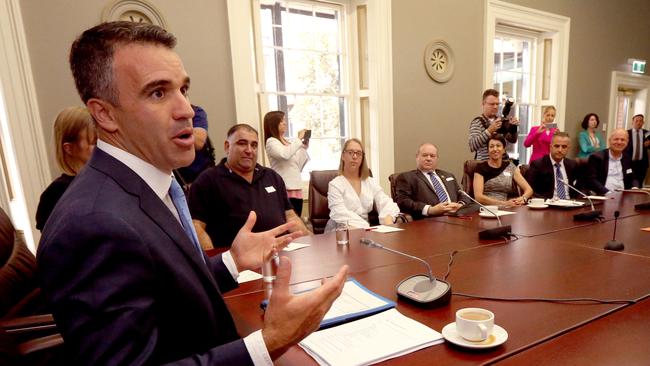Steven Marshall analysis: His strengths, weaknesses, opportunities and threats
LIBERAL leader Steven Marshall is trying to lead his party into government after 16 years in the electoral wilderness. We examine the positive and negative factors in his tilt to become the state’s next premier.
SA 2018
Don't miss out on the headlines from SA 2018. Followed categories will be added to My News.
- Liberal leader Steven Marshall launches online profile
- Pledge to scrap payroll tax for businesses under $1.5m wages
- Jay Weatherill analysis
- Nick Xenophon analysis
STRENGTHS
IN a party infamous for infighting, Steven Marshall has managed to preserve a veneer of peace. The Liberals have had two leaders since 2009 – Isobel Redmond was the other – after a revolving door of three in three years.
After a disastrous loss when on the brink of power in 2014, Mr Marshall has recovered relatively well. He has forged a co-ordinated team, fusing the party’s moderate and right groupings with the shared aim of finally toppling Labor from power.
In particular, party elders have set aside long-held rivalries to advise him. Right warriors such as former premier John Olsen (now state president) and former federal finance minister Nick Minchin (one of the nation’s most-skilled political strategists) have been working alongside moderate federal Education Minister Simon Birmingham and senior SA Liberal Christopher Pyne. Even former prime minister John Howard has been mentoring Mr Marshall. Knitting together this coalition of Liberal elders – without sparking factional war – requires skill that should not be underestimated.
As he displayed at this month’s SA Press Club debate, Mr Marshall has honed his ability to weave together a political argument – a failure in this regard cost him at the 2014 election when he had been in parliament just four years.
His 2036 manifesto, while not as groundbreaking as some Liberals suggest, provides an extensive and coherent framework for policies, including deregulating shop trading hours and scrapping payroll tax for small business.

WEAKNESSES
A LOSER mentality continues to infect sections of the party, which bizarrely is coupled with a lazy sense of entitlement clouded by blind hatred for Labor. This means some believe the Liberals are a shoe-in because of a favourable electoral redistribution and mounting Labor failures after 16 years in office. As Mr Howard warned the state party room in 2016, they cannot rely on these for victory. Some will.
A businessman before entering parliament, Mr Marshall is not a natural politician. He lacks the veiled ruthlessness of Premier Jay Weatherill or the easy spin of SA Best leader Nick Xenophon. He abandoned the Liberal base when ditching support for further investigation into a proposed nuclear waste repository worth up to $500 billion.
His party-elder advisers are a double-edged sword – the gaggle of former leaders and ministers prompts the question of who runs the show. There is a sense Mr Marshall has remained leader because of a lack of alternatives and that no one better has come along. This fuelled a wistful longing, in some quarters, for Alexander Downer to take over.
Turbulence in Canberra – Barnaby Joyce’s baby, the Murray-Darling Basin imbroglio – washes into the state and buffets the Liberal campaign, simply because the Coalition holds federal power and carries the can.
Hopefully for the Liberals, Mr Marshall does not repeat his infamous last-minute election pitch of 2014, when he told South Australians “they need to vote Labor tomorrow”.

OPPORTUNITIES
LABOR is asking voters for 20 years in power. For a government of any persuasion, this is an extraordinarily long time. It creates a mood for change, which the Liberals have had plenty of time to work out how to capitalise on.
There have been plenty of Labor blunders, in health, education, child protection, job creation ... the list goes on. The Liberals have been reasonably effective in attacking Labor and now have the chance to offer credible solutions.
As in 2014, jobs and the economy are the most important issues. These have traditionally been considered areas of Liberal strength by many voters. This should offer fertile ground for Mr Marshall.
Mr Xenophon has been riding high in the polls but has been distracted by attacks from Mr Marshall and Mr Weatherill. If he has spread himself too thinly and can be exposed on policy, in particular, the Liberals are presented with the opportunity to swoop, gather up wavering SA Best supporters and harness a mood for change.
Federal incumbency can be an advantage. Easier access to Canberra’s coffers and influence can be a benefit to Mr Marshall, if both arms of the party are not weighed down by unpopular distractions.
Mr Marshall might be secretly praying for another statewide blackout. Even with the popularity of renewable energy, Mr Weatherill would be hard-pressed to defend his $550 million power plan in the event of another grid failure.

THREATS
IF THERE is a mood for change in SA after years of Labor, it would seem to be heading Nick Xenophon’s way. Just when the Liberals thought they could finally end Labor’s rule, the upstart SA Best is capitalising on global disaffection with the established political order.
If Mr Xenophon was not in the lower house race, Mr Marshall would be feeling a lot more comfortable about his chances of being premier after March 17.
SA Best dilutes both major parties’ votes, but has hurt the Liberals more. The federal stronghold of Mayo was lost in 2016 and Barker and Grey were closer races than might have been expected.
The Liberals have papered over a historic split in their ranks. Former party president Cory Bernardi forming the Australian Conservatives, then merging with Family First, also threatens to rob them of some votes. Just as importantly, Senator Bernardi’s active presence might stoke the flames of factional warfare that have been suppressed for a few years.
Mr Marshall’s right-hand man, Rob Lucas, is a veteran operator who is particularly adept at infuriating Labor. But an Advertiser-Galaxy opinion poll in 2016 found ETSA’s 1999 privatisation was the major source of public blame for soaring power prices. Mr Lucas was treasurer from 1997-2002, presenting Labor with an obvious attack ad target (along the lines of “this bloke ruined our power system, now he wants another chance to stuff it up again”).
Incumbency provides many benefits, particularly to milk government spending and projects to an election timetable. Labor has done this effectively. South Australians have not changed government often. The last time the Liberals won from Opposition was in 1993, after the State Bank financial disaster. The conservatism of the electorate, in a turbulent time, might just prompt people to stick with what they know.



